Energy
- Energy: capacity to do work
- Work: exertion of force overcoming resistance or producing molecular change
- Exothermic reaction gives out heat
- Endothermic reaction absorbs heat
Direct + Indirect uses of Energy
Direct
- Burning petrol to power a car
- Burn car to power a steam train
- Burn natural gas to use a stove to cook eggs Indirect
- Takes energy to process crude oil to separate petrol. Then consumers use the petrol to power the car
- Burning coal to spin turbines to generate electricity to charge a laptop. Consumers use the energy stored in the laptop
- Truck bringing of diesel to transport eggs to consumers
Greenhouse Effect
- Complete combustion: reacts with air to produce carbon dioxide and water
- Incomplete combustion: reacts with air to produce carbon monoxide and water, or carbon and water
With the burning of fossil fuels, we put a lot of carbon dioxide into the air.
Cause + Effect enhanced
- Extra burning of fossil fuels
- Enhanced greenhouse effect
- Average global temperatures rise
- Ice melting and sea level rises
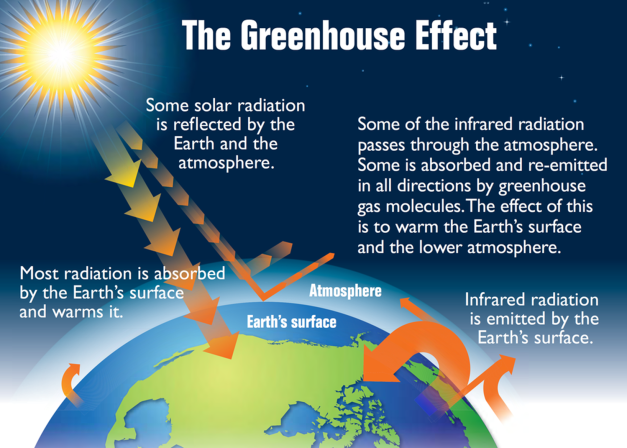
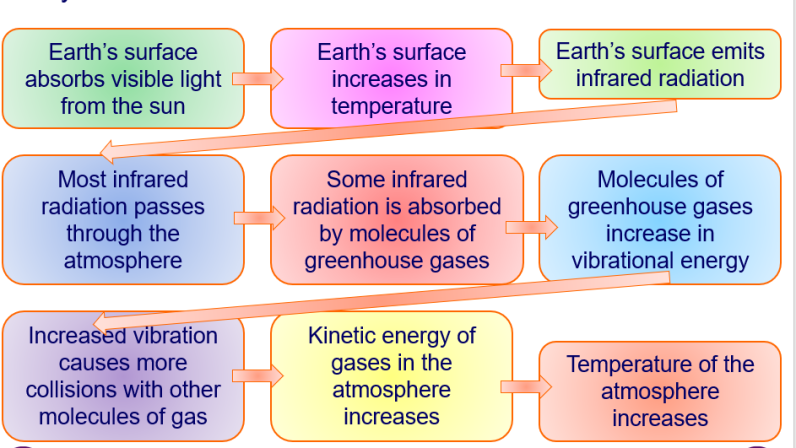
- Some sunlight is absorbed by greenhouse gases. However, the kinetic energy formed by the greenhouse gasses moving and the absorbed sunlight, heats up the earth
Combustion
- Combustion: substance burns in the presence of oxygen
- Reaction between a substance and oxygen that releases heat and light energy
- Fuel: substance that reacts with oxygen (combusts) to produce useful energy
- Many fractions obtained from crude oil are used as fuels because they contain hydrocarbons that burn easily and release a large amount of useful energy
- Complete combustion: lots of oxygen present
- Hydrocarbon + oxygen —> Carbon dioxide + water + energy
- If there is a shortage of air(oxygen), incomplete combustion takes place
- Incomplete combustion: limited oxygen present
- Hydrocarbon + oxygen —> Carbon dioxide + water + energy
- Still yields carbon dioxide and water
- However, it produces toxic by-products, in CO and C
- Also releases less energy than complete oxygen
- Carbon monoxide is poisonous because it reduces the ability of blood to carry oxygen, and reduces the ability of blood to expel carbon dioxide
Balancing equations: Combustion
- Balance C
- Balance H
- If oxygen is an odd number, times everything by 2
Heat of combustion is used to refer to the amount of heat released during a combustion reaction
- Involves combustion of a measured mass of alcohol to heat a measured mass of water over a measured temperature rise
- It is assumed that the total heat released by the combustion reaction will be absorbed by the water
The heat of combustion can be calculated with:
- ∆H: change in enthalpy (j)
- m: mass of heated substance (g)
- c: specific heat capacity of heated substance (˚C)
- ∆T: change in temperature of heated substance
Energy in Chemical Change
Understanding Energy
- Energy: capacity to do work
- Measured in Joules
- Can be transferred or transformed
- Can therefore come in different forms
- Potential energy
- Chemical energy
- Nuclear energy
- Mechanical energy
- Elastic energy
- Gravitational energy
- Kinetic energy
- Heat energy
- Light energy
- Electrical energy
- Sound energy
- Enthalpy: changes taking place in a chemical reaction
- Total energy present in a reaction
- △H = H(products) - H(reactants)
- H: enthalpy
- △H: change in enthalpy
2 prefixes: system and surroundings
System: the area in which the chemical reaction happens
Surroundings: Contents outside the system that energy is transferred to/from
2 types of reactions
Exothermic reactions: transfers energy from system to surroundings
- Energy is released
- Bonds are broken
- Heat is transferred/released from system to surroundings
Endothermic reactions: transfers energy from surroundings to system
- Heat is transferred/absorbed from surroundings to system
Energy is stored in chemical bonds, known as chemical potential energy, or bond energy
Exothermic reactions have a negative value for △H, meaning enthalpy has decreased for the duration of the reaction
- Happens if chemical potential energy is converted to particle kinetic energy, e.g. increase in temperature
- Overall chemical potential energy is conserved in the form of heat
- However, this raises the system’s temperature, so heat flows away from the system to the surroundings
- The loss of heat energy from the system to the surroundings means that enthalpy has decreased
Endothermic reactions have a positive value for △H, meaning enthalpy has increased for the duration of the reaction
- Particle kinetic energy is converted to chemical potential energy
- Reduction of particle kinetic energy means reacting system’s temperature will fall
- Heat flows from the surroundings to the system, increasing enthalpy
Representing Energy Changes in Chemical Reactions
- Enthalpy change can be shown graphically using an energy profile graph, or it can be written along with the equation
- Sometimes the heat absorbed or released during the reaction is written into the equation, rather than giving the enthalpy change
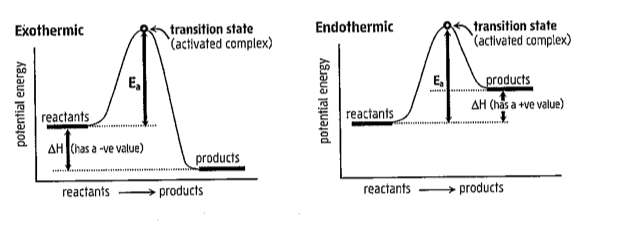
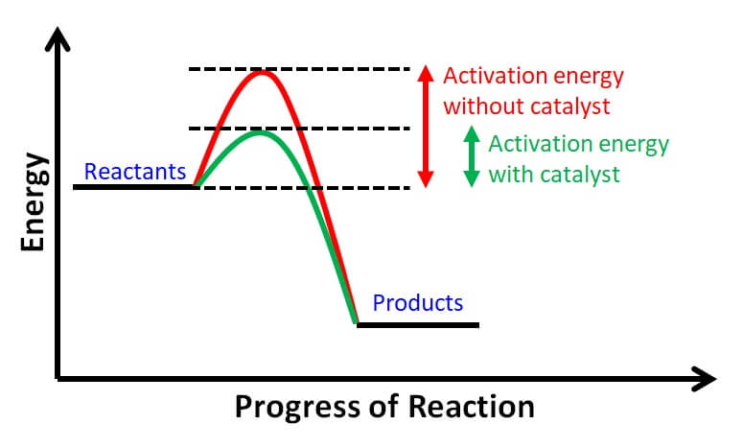
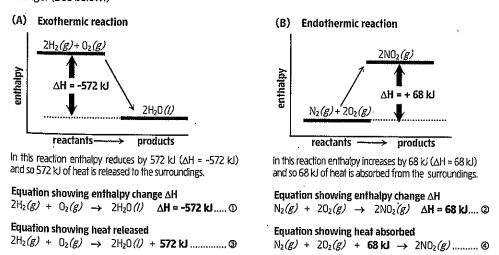
- When a catalyst is used, less energy is needed for a reaction to occur
- Activation energy: amount of energy required to start/sustain reaction
- catalyst: substance that lowers activation energy of the reaction, and is not consumed during the reaction